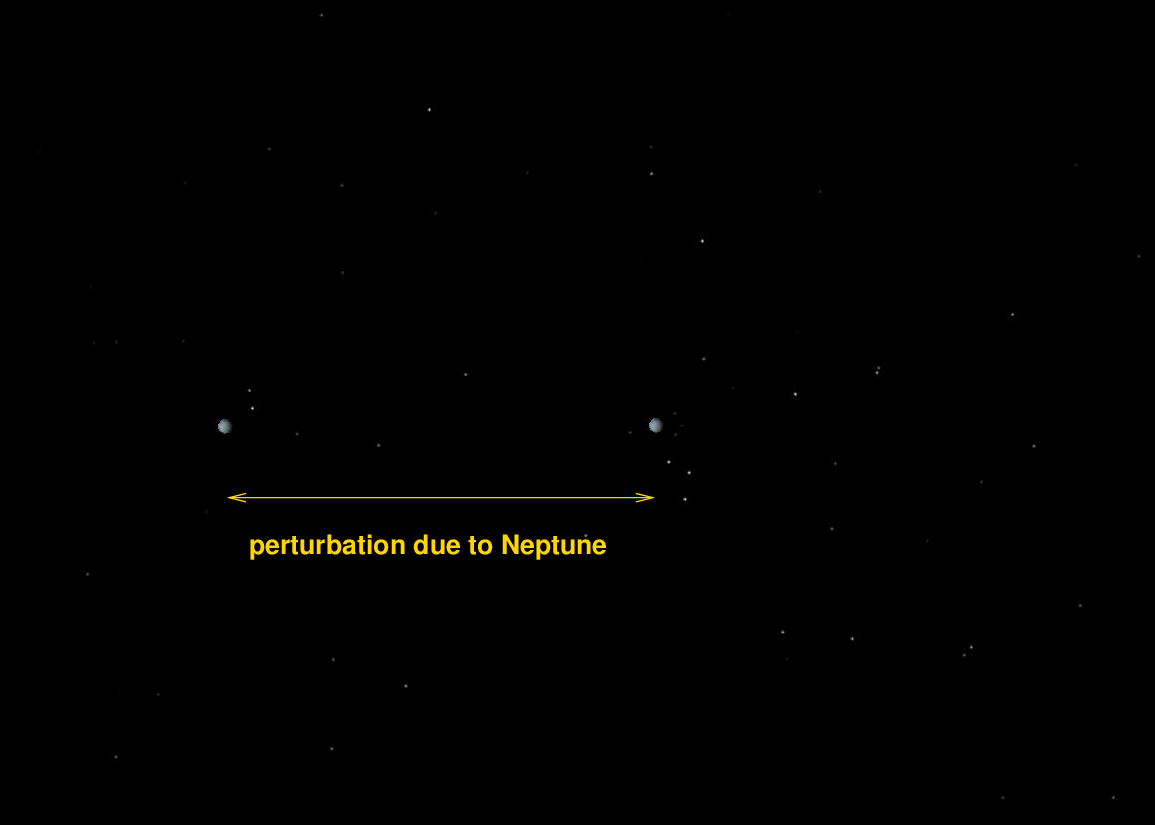
 Copyright © Michael Richmond.
This work is licensed under a Creative Commons License.
Copyright © Michael Richmond.
This work is licensed under a Creative Commons License.
Today, we'll look in detail at just TWO of the objects which orbit the Sun far beyond the inner solar system. The focus today is on bodies which remain far from the Sun, so their lives are relatively sedate. Next time, we'll look at what happens to icy bodies with orbits that bring them into the warm reaches of the inner Solar System (spoiler alert: they turn into comets).
As you may recall, two 19th century astronomers used irregularities in the motion of Uranus to predict the position of a new planet. It worked once ... could it work again?
As the 1800s turned into the 1900s, measurements of the position of Uranus continued to show some small differences from the predictions of Newtonian gravity. These weren't nearly as large as they had been before the discovery of Neptune, but they were still present.
When Adams and Leverrier compared the predicted position of Uranus to its actual position, they found differences of more than 100 arcseconds -- pretty obvious to any good observer.

Once Neptune was found, and its orbital properties and mass measured as carefully as possible, astronomers in the late 1800s and early 1900s noticed that there was still a small error in its apparent position. The difference was now only a few arcseconds ...
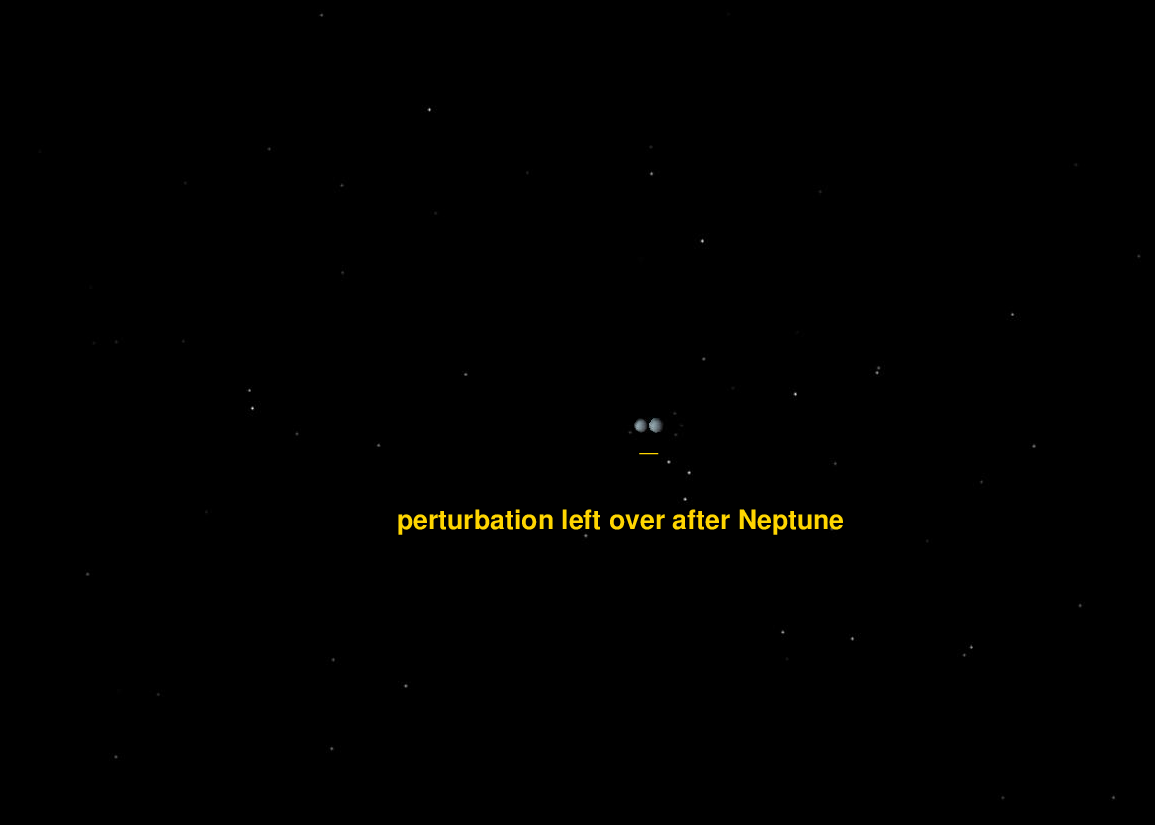
... but could it be used to discover ANOTHER planet?
One of the scientists who took up this challenge was Percival Lowell.
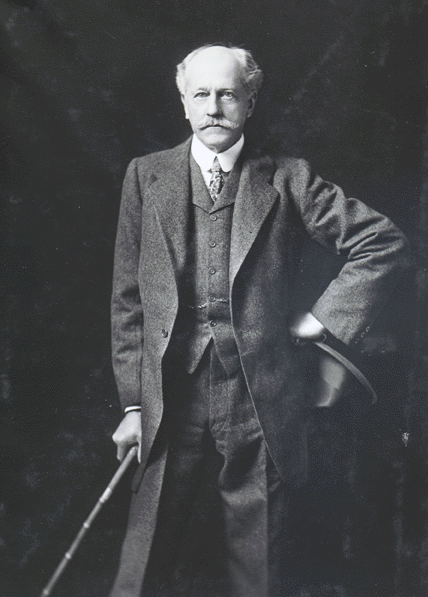
Image courtesy of
Lowell Observatory Library Catalog and Archives
Lowell was one of the vanishing breed of gentleman scientists who had dominated the English scientific establishment in the 1700s and early 1800s. His family's wealth enabled him to follow his interests in travel, science, and especially astronomy. He was captivated by Giovanni Schiaparelli's descriptions of markings on the planet Mars in the late 1870s.
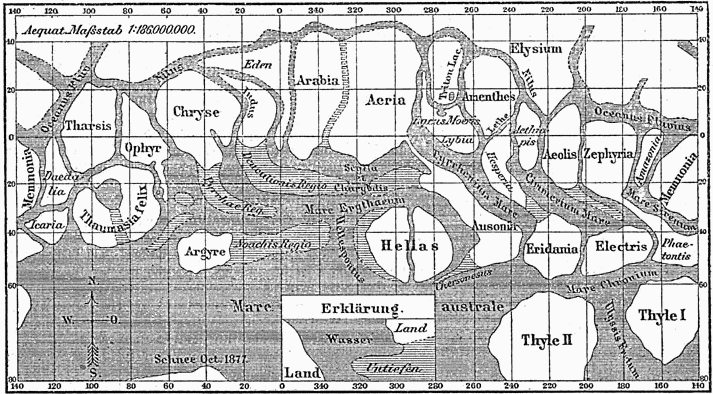
Image courtesy of
Stefan Kuhn and Wikimedia
When other scientists agreed that the markings were real features, Lowell decided to enter the fray. He ordered the construction of an observatory on a mountain in Arizona, and hired the scientific staff to carry out a plan of systematic observations of the planet during its favorable opposition of 1894. He compiled the results of his own measurements, as well as those of the staff, into the book Mars.
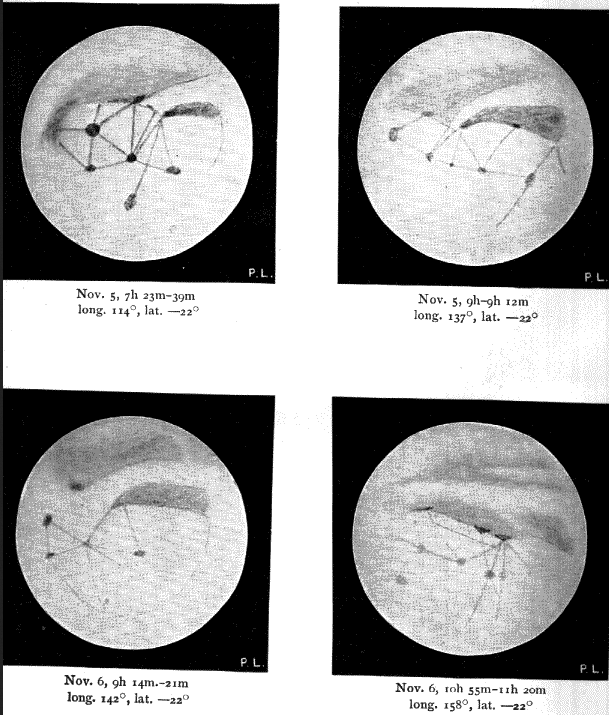
Plate XXV taken from Lowell's book
Mars.
While Lowell and his staff continued to study Mars for the next few decades, he also started several other projects. One of these was the search for what he called "Planet X", the distant body beyond Neptune which caused the small irregularities in the motion of Uranus. He employed a team of computers -- we would call them "mathematicians" nowadays -- to carry out by hand the long, long, long series of calculations necessary to determine the most likely location of this mysterious object. For a number of reasons, he adopted as a starting point for the computations the assumptions that the new object
But as he and the team performed their work, it became clear that the properties of Planet X would have to change. Lowell ordered a series of photographic surveys to cover large regions of the sky where the object might lurk. Between 1905 and 1909, a small (5-inch diameter) camera was used for the job; when it proved inadequate, a much larger instrument (40-inch reflector) was used for a second series of plates taken from 1910 to 1915. Although these searches revealed a wealth of information on objects in the sky -- over 500 asteroids and 700 variable stars -- they failed to show the object Lowell sought.
Actually, Pluto does appear, very faintly, on two plates taken in the spring of 1915, but its nature was not recognized at that time. The images were noticed only after Pluto's discovery in 1930, when astronomers checked their plate archives at its now-known positions.
On November 12, 1916, Percival Lowell died, bringing the search for Planet X to a halt -- for a time. Before his death, Lowell published a detailed description of his work, which contained his best estimates for the properties of the perturbing object. The calculations indicated that Planet X should be in one of two areas, on opposite sides of the sky.
option A option B
------------------------------------------------------------------
semi-major axis 43.0 AU 44.7 AU
eccentricity 0.202 0.195
mass 6.7 MEarth 6.7 MEarth
Right Ascension 05:33 17:29
Declination +23 -23
Constellation Taurus Ophiuchus
------------------------------------------------------------------
The first option meant observing the winter sky ...
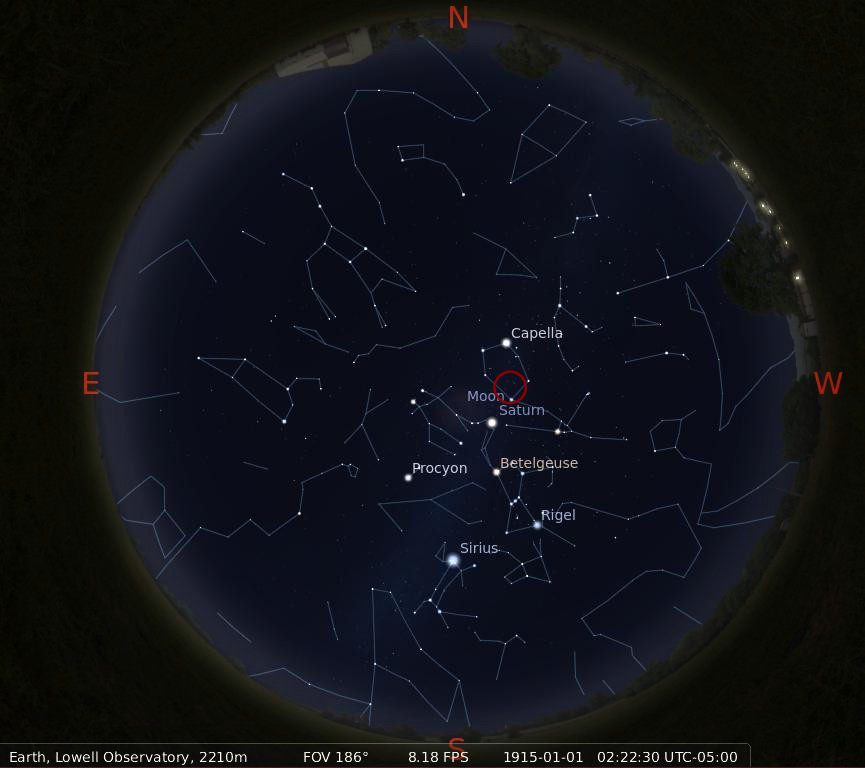
while the second meant that Planet X would be visible in the summer:
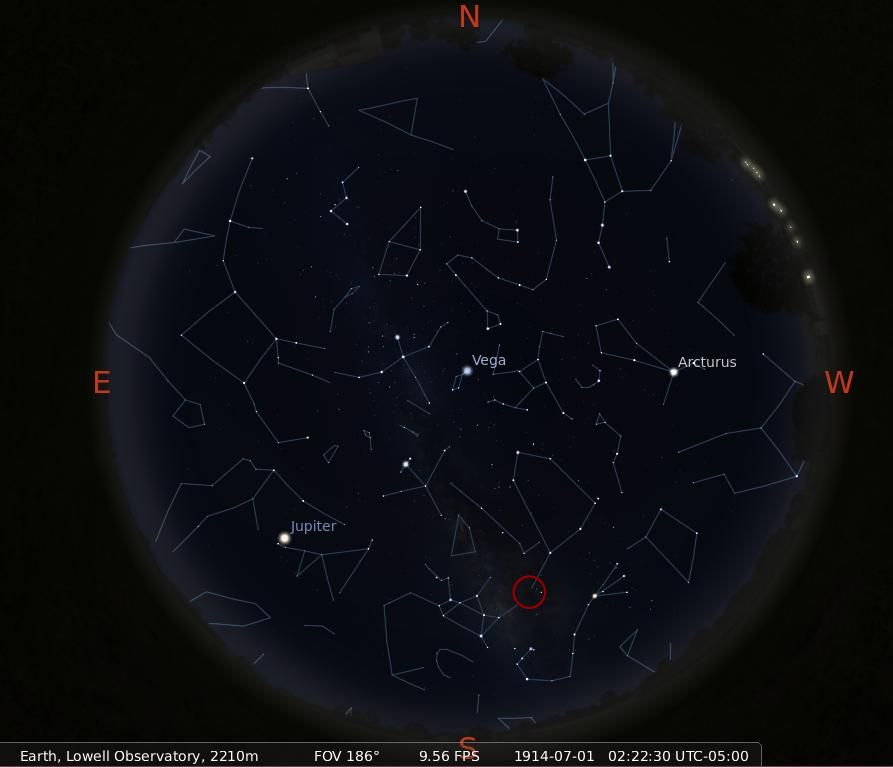
For roughly 10 years after Lowell's death, the search for Planet X languished. But when Lowell's nephew, Roger Putnam, became trustee of the Observatory in 1927, he agreed to resume the effort. Over the next two years, Lowell Observatory prepared for a new search. A new camera was built, using an excellent 13-inch lens which gave sharp images over an entire 14x17-inch photographic plate, covering an area of 12 by 14 degrees on the sky. The camera recorded stars down to magnitude 17 in a one-hour exposure, almost 100 times fainter than the brightness Lowell had predicted.
Of course, that "one hour exposure" meant that someone had to sit quietly next to the telescope, out in the cold, constantly checking the positions of stars in an eyepiece and making small adjustments to the telescope's tracking -- for an hour. Who would take a job like that?
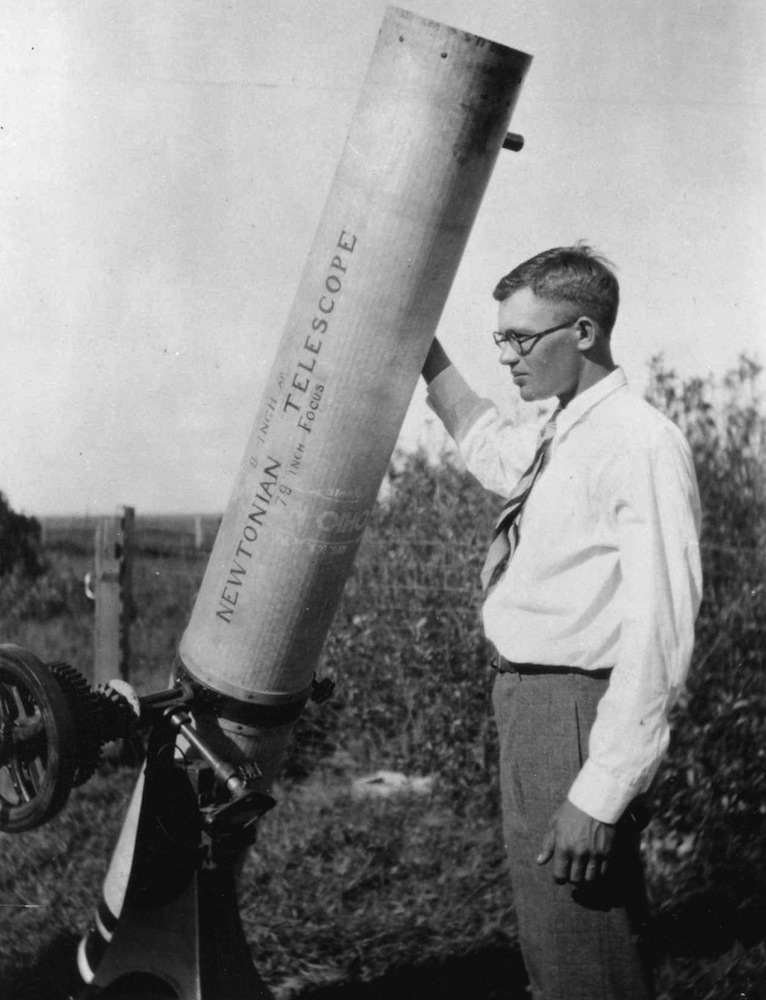
Image courtesy of
Wikimedia
A twenty-two year old from Kansas, that's who. Clyde Tombaugh had graduated from high school in 1925, and, as he wrote later,
Since then, my summer seasons were given to farming, my winters to constructing telescopes.
The photograph above shows him standing next to his home-made 9-inch reflector at his family's farm in Kansas. Tombaugh was hired in early 1929 and moved to Flagstaff. He was excited to work at an observatory, but didn't quite know what to expect. He soon found out.
Only after arriving in Flagstaff did I realize that I was to join in the search for a new planet, and what it is like to work all night long in an unheated dome in winter at 7,000 feet altitude.
In April, 1929, Tombaugh started the photographic search for Planet X. It was a much tougher job than looking for Neptune. Neptune, as you may recall, was predicted to be -- and found to be -- magnitude 8. That's not bright enough to be seen with the naked eye, but not very faint: one can spot it with a good pair of binoculars. But Pluto was predicted to be about 100 times fainter: magnitude 13. And, as Tombaugh would find it, the real Pluto was fainter still, close to magnitude 15.
Why is that bad? The problem is that the number of stars increases rapidly as one considers fainter and fainter targets. In 1846, when Galle and D'Arrest examined a region of the sky about 5 by 5 degrees looking for Neptune, they only had to check 30 or 50 stars against a catalog. But Tombaugh would have to do more work:
magnitude number of stars number of stars
per sq. degree per plate
---------------------------------------------------------------
8 1.2 200
10 5 770
13 66 11,000
15 300 50,000
---------------------------------------------------------------
Each plate was big -- almost a foot and a half wide, and covered with tens or hundreds of thousands of tiny specks representing stars. The image below is a copy of one of the plates on which Tombaugh discovered Pluto. Click on the de-magnified version below to see a copy at full resolution.
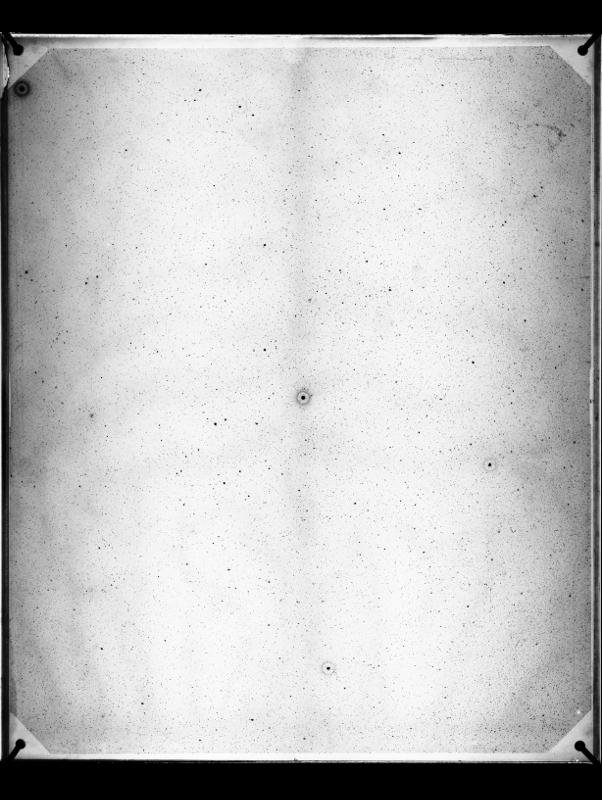
Image courtesy of
National Air and Space Museum, Smithsonian Institution
The plate covers an area of about 12 by 14 degrees on the sky, and contains images of thousands of stars. Tombaugh had to scan each plate with a magnifying glass or microscope to check for the presence of the expected faint speck of light. Consider one little section of this entire plate -- about 1/700 of the entire area:
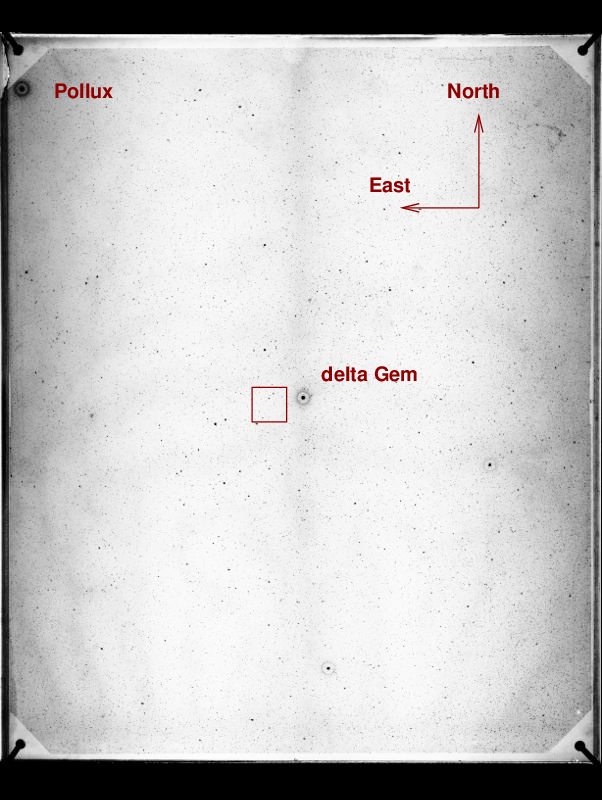
Image courtesy of
National Air and Space Museum, Smithsonian Institution
Below is a copy of this teeny-tiny portion of the plate taken on Jan 23, 1930. North is up, East to the left, and the image is about 30 arcminutes on a side.
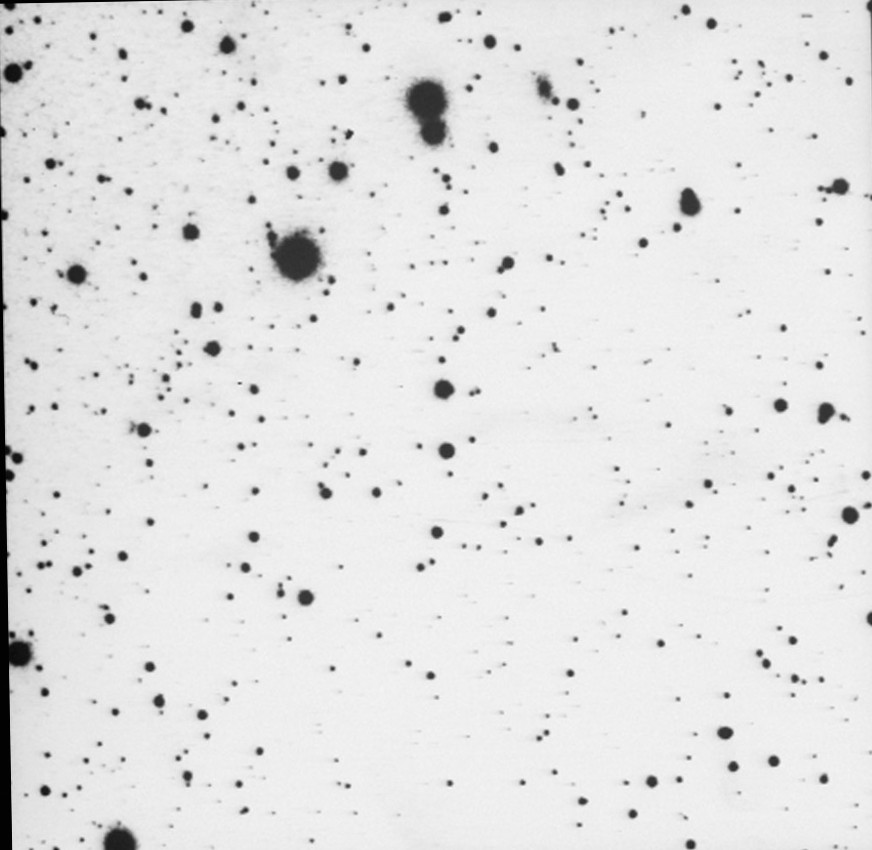
Image courtesy of
Lowell Observatory Archives and the Planetary Society
Below is a copy of the same teeny-tiny portion of the plate, taken on Jan 29, 1930. North is up, East to the left, and the image is about 30 arcminutes on a side.
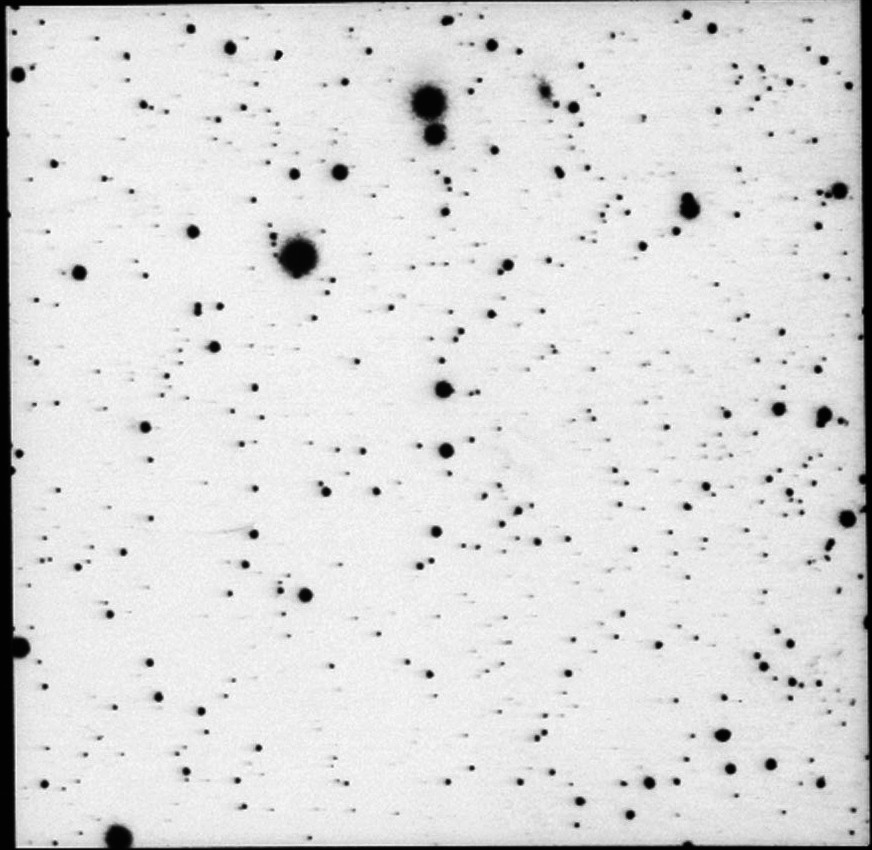
Image courtesy of
Lowell Observatory Archives and the Planetary Society
Can you spot the object which moves?
Maybe it would help if you could see them side by side.
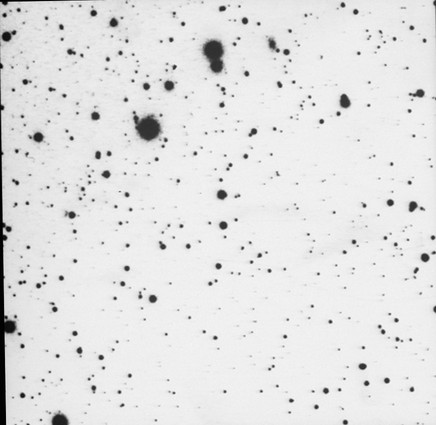
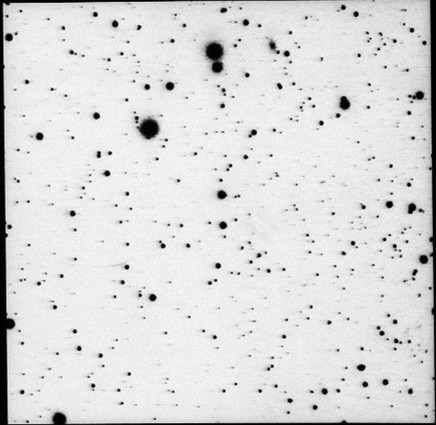
Images courtesy of
Lowell Observatory Archives and the Planetary Society
No? Still can't find it? Perhaps it would help if you used the same technique that Tombaugh did, called blink comparison. He used a machine with optics which sent an image from one plate to an eyepiece, and an image from the other plate to the same eyepiece.
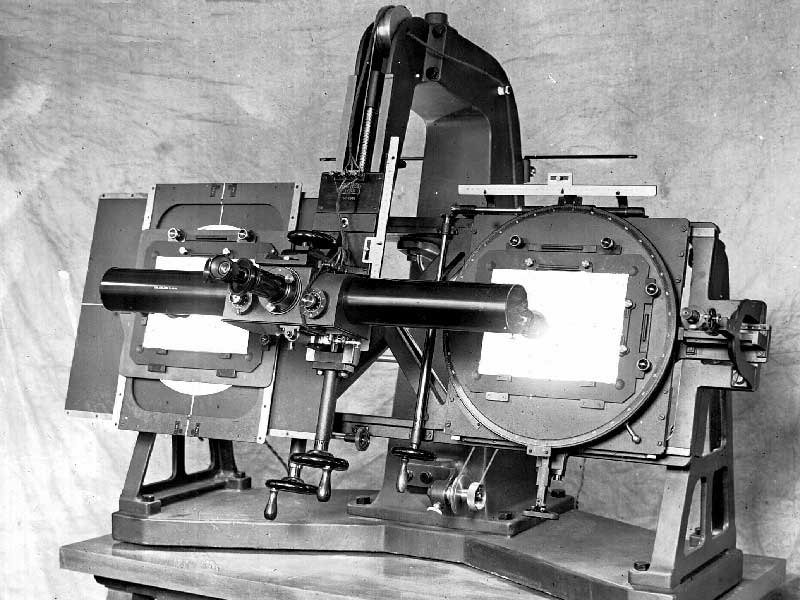
Image courtesy of
Sightsize.com
original source unknown
After aligning the images carefully, he could flip a lever and switch quickly between the two images. Human brains are very good at noticing objects which appear to move or "jump" between two locations.
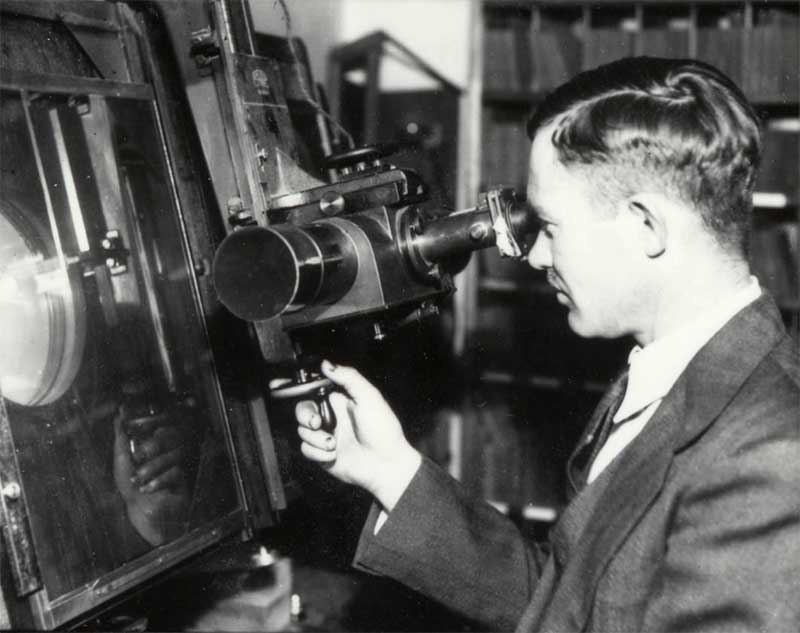
Image courtesy of
Lowell Observatory Archives
You can try it yourself by clicking on the image below, which will start the two teeny-tiny sections shown above "blinking" with time.
The scientists of the New Horizons team at Johns Hopkins have created a software version of the blink comparator, with versions of Tombaugh's discovery images in place. Click on the image below to use their "blink comparator simulation."
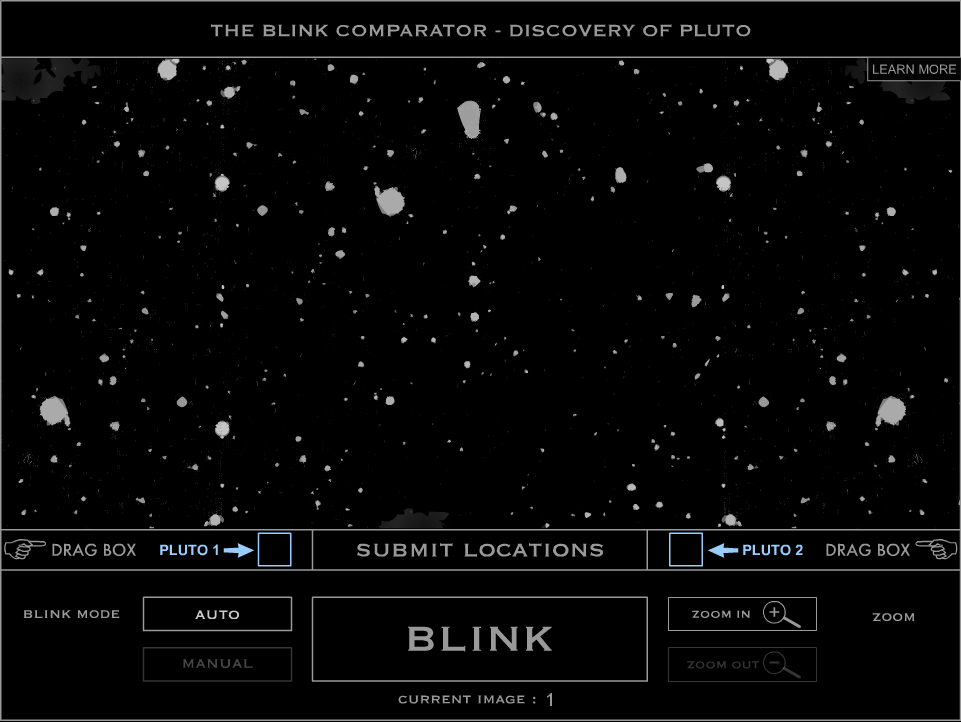
Blink tool courtesy of
New Horizons at JHU/APL
On March 13, 1930, which happened to be the seventh-fifth anniversary of Percival Lowell's birth, the Observatory sent out an announcement to astronomers around the world.
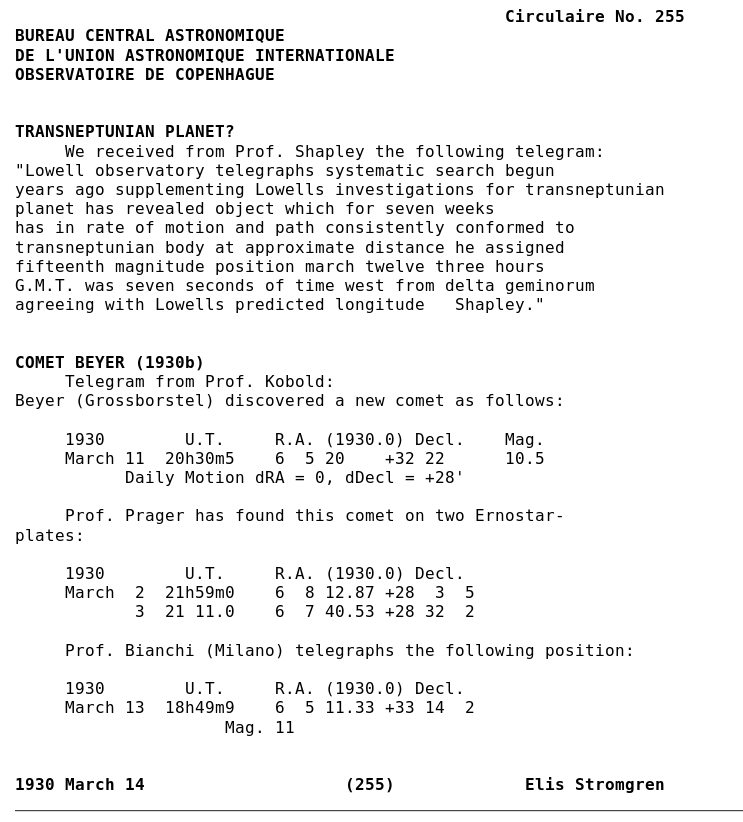
IAU Telegram 255 courtesy of
Central Bureau for Astronomical Telegrams
After several months, astronomers decided to name this new object Pluto, and give it a symbol which contains the two letters "P" and "L", which are the first two letters in its name, but also the initials of Percival Lowell.
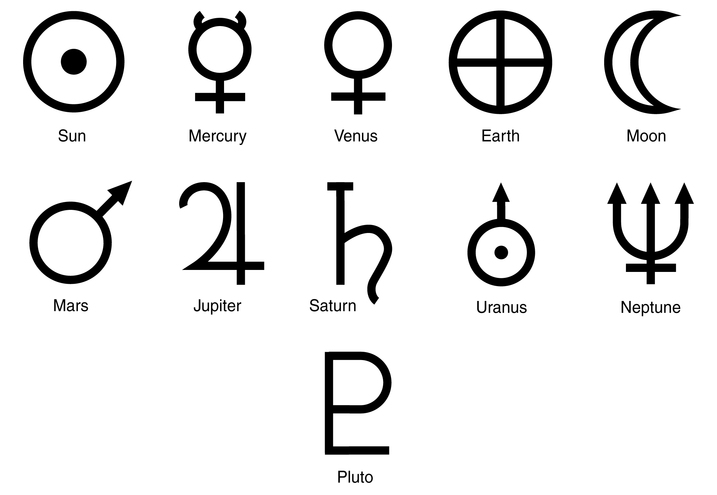
Image courtesy of
NASA/Lunar and Planetary Institute
Finding Pluto was definitely a good thing ... but was it really a triumph of celestial mechanics? Remember, Lowell had based his prediction for its position on small residuals in the motion of Uranus. Did the new object really appear close to the location he computed?
Let's first compare the orbital elements of his prediction to the actual orbit of Pluto.
prediction actual
------------------------------------------------------------------
semi-major axis 43.0 AU 39.5 AU
eccentricity 0.202 0.244
ecl. longitude 103 deg 109 deg
------------------------------------------------------------------
Not bad. Not bad at all.
But there's one little problem. Little -- well, maybe a big problem. In order to explain the changes in Uranus' motion via gravitational forces from the new object, Lowell had to assume that the object had a pretty big mass: about 1/50,000 of the Sun, which corresponds to about 6.7 Earth masses.
When Pluto was discovered in 1930, it was somewhat fainter than expected, which suggested it might be smaller than the prediction; but we had no way to determine its mass. Fortunately, in 1978, James Christy at the US Naval Observatory noticed a slight elongation in images of Pluto. The elongation changed position with time in a periodic manner. Christy realized that this little "bump" was actually due to a moon orbiting Pluto. He named the moon "Charon", after the ferryman who carries shades to the realm of Pluto in Greek mythology.
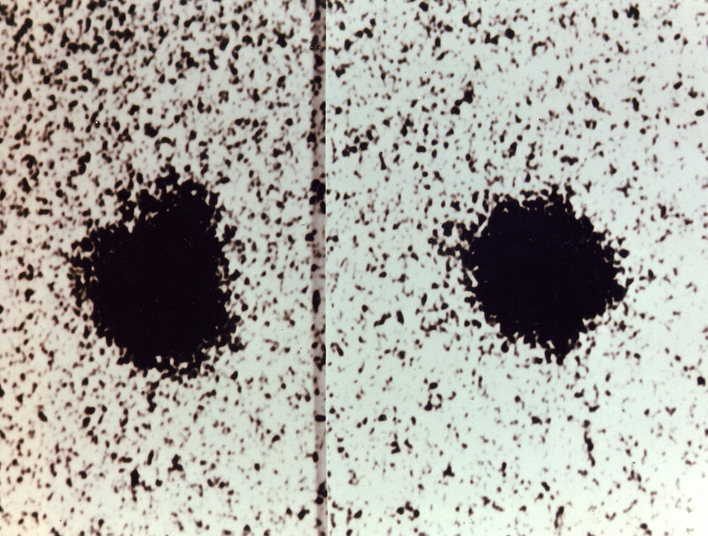
Image courtesy of
U.S. Naval Observatory
(Our images of Charon have improved a bit since 1978, by the way)
As soon astronomers were able to measure both the period (about 6.4 days) and the separation (about 19,640 km), they could use Kepler's Third Law to figure out the mass of Pluto. To a rough approximation (the mass we compute below is actually the combined mass of Pluto and Charon)
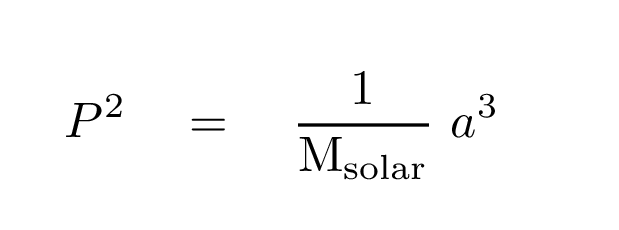
Now, in the case of Pluto, we need to use
19,640
a = 19,640 km = -------------- AU
149,600,000
6.4
P = 6.4 days = ------------- year
365.25
Q: What is the mass of Pluto in solar units?
Q: The mass of the Sun is about 333,000 times the mass of the Earth.
What is the mass of Pluto in Earth units?
As you can see, the mass of Pluto turns out to be much too small to explain the residuals in the motions of Uranus.
Strange.
It gets even stranger with time. Over the next 50 years, as astronomers made more accurate measurements of the motions and the masses of the planets, the small discrepancies in the measured positions of Uranus ... disappeared!
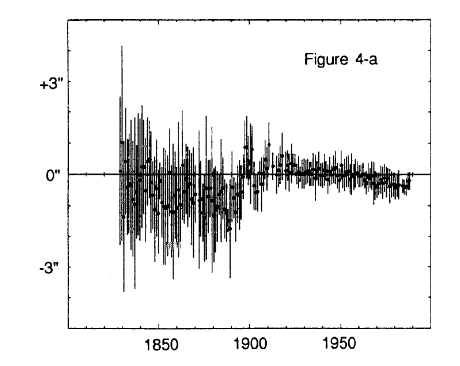
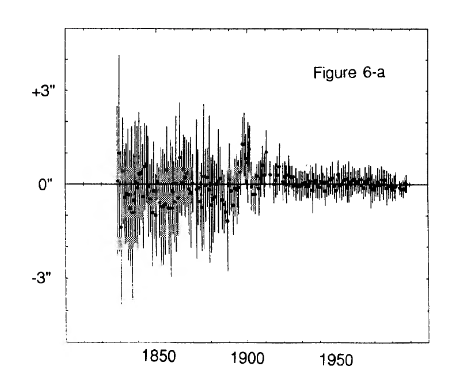
Figures 4-a and 6-a taken from
Standish, AJ 105, 2000 (1993)
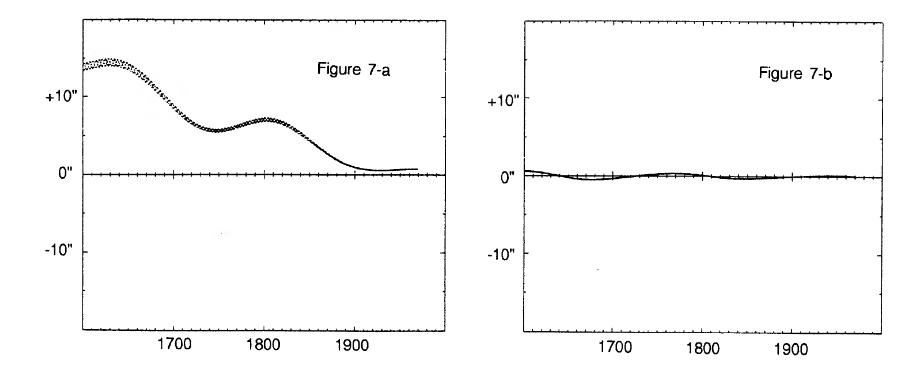
Figures 7-a and 7-b taken from
Standish, AJ 105, 2000 (1993)
Those residuals in the motion of Uranus: they turn out to be, for the most part, errors in the CALCULATIONS, due to biases in the astrometric catalogs, and due to incorrect masses of Jupiter and Saturn, and Neptune.
It seems that Lowell's calculations were based on incorrect data ... and so his prediction could not be correct. The fact that Tombaugh found a planet in roughly the prediction position, with roughly the predicted distance from the Sun, was just a coincidence.
Still, if Lowell had not believed that such an object DID exist, he would not have started and funded the search for it ... and Tombaugh would not have found Pluto.
By the way, after finding Pluto in 1930, Tombaugh continued to take photographs of the region of the sky near the ecliptic (where the planets are found) for the next decade. He discovered many, many asteroids and variable stars, but no more trans-neptunian objects.
And so things remained for many years. Pluto joined the list of planets in the Solar System, but it remained a lonely, isolated body.
Some astronomers, however, thought that there might be other bodies in those dark, cold regions. One of them was David Jewitt. Whenever he could, he took long exposures with big telescopes to search for any evidence of objects orbiting the Sun at large distances. He spent years grabbing images when he could and scanning them for slow-moving objects. In 1992, he and his graduate student, Jane Luu, noticed something peculiar in a series of CCD images taken at roughly hourly intervals with the University of Hawaii's 2.2-meter telescope on Mauna Kea.
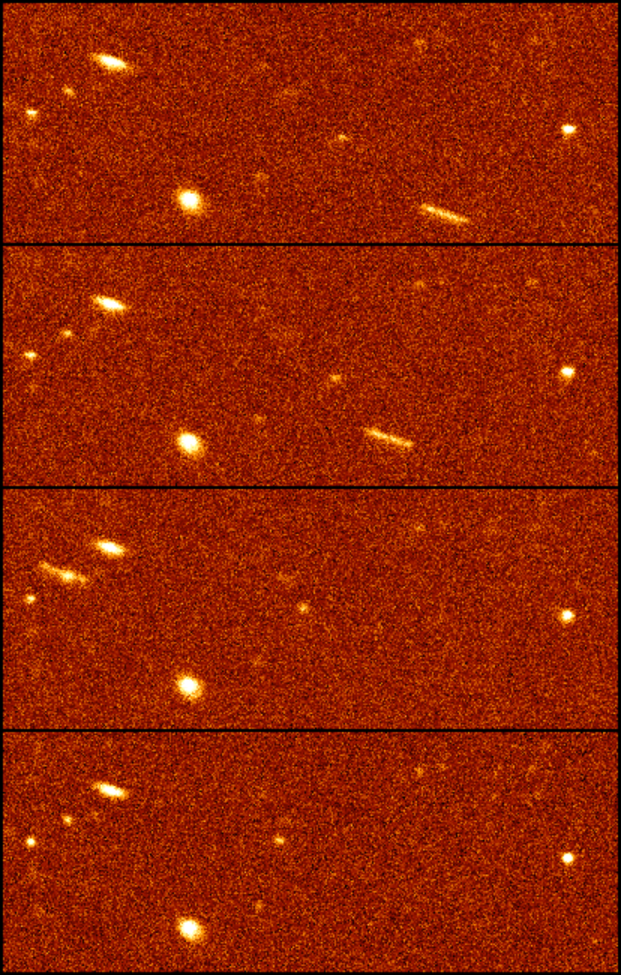
Image courtesy of
David Jewitt
Q: Can you find the moving object?
The motion of the object over the next few days clearly showed that its orbit was about 40 AU in size. It was another planet! Or was it?
One clue that this was different from Pluto, and not a planet, was its brightness. The object was MUCH FAINTER than Pluto: at magnitude 23, it was nearly 600 times fainter! There was no way that this could be an object as large as Pluto, let alone the Earth. This was more like an asteroid than a planet, as Jewitt and Luu state in their discovery announcement.
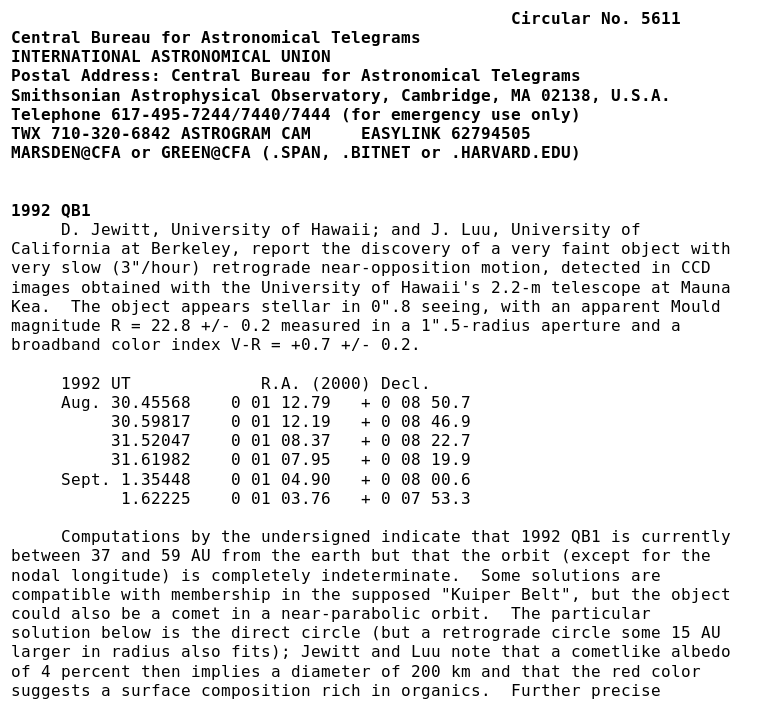
Image courtesy of
Central Bureau for Astronomical Telegrams
Over the next few years, other astronomers found additional small bodies at similar distances from the Sun, and even more have been discovered recently. The job has changed dramatically from Tombaugh's day, thanks to electronic cameras and computer technology. These days, many objects are "found" by computer programs which sift through all the objects detected in CCD images, looking for those which move over the course of several hours. No one is sitting out in the dark, cold dome, any more, guiding the telescope's motion with one eye glued to the eyepiece.
And that's probably a good thing.
Our current inventory of objects in the outer Solar System shows a "clump" between 35 and 50 AU, containing (as of Oct 2018) 2180 bodies.
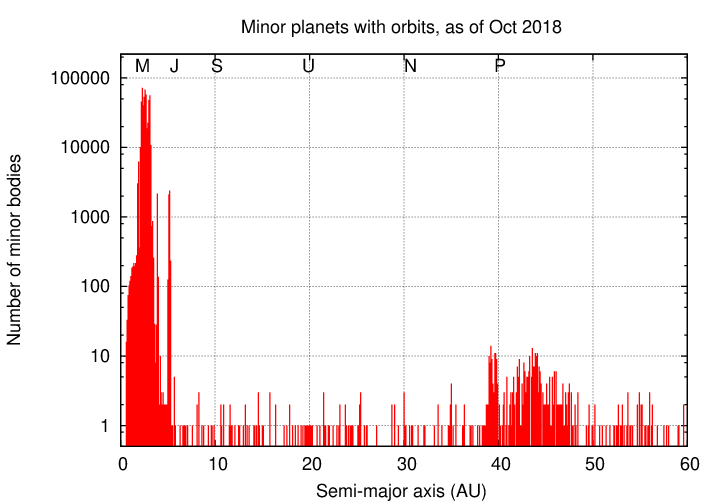
There are a few hundred objects at even greater distances, with semi-major axes going out to nearly 1000 AU.
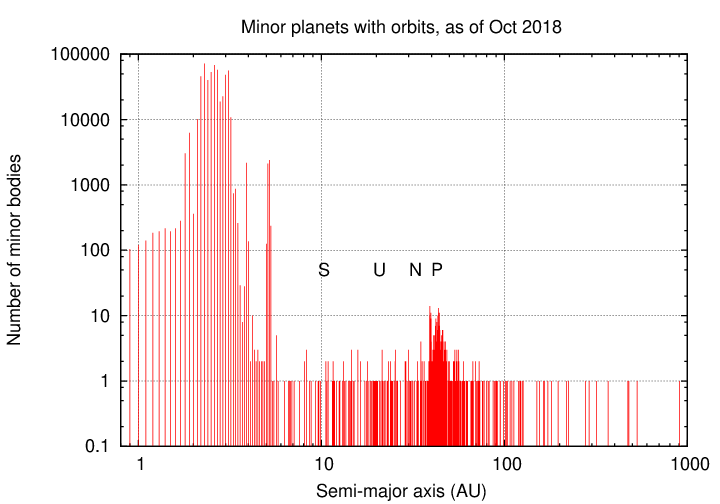
But what's the deal with that "clump" at around 40-45 AU?
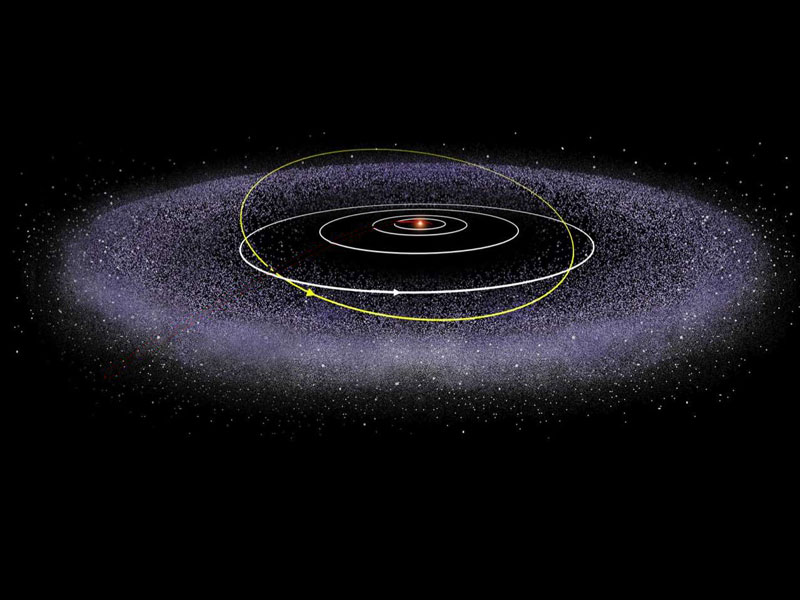
Image courtesy of
NASA
It turns out that several theorists had predicted that some icy bodies might inhabit this particular neighborhood. Gerald Kuiper, for example, speculated in the 1950s that objects like asteroids, but composed primarily of ices instead of rocks, might have formed in this location during the early stages of the Solar System. However, since Kuiper believed that Pluto had a mass larger than that of the Earth, he concluded that these bodies would have been thrown out of this region by the gravitational effects of that (incorrectly) massive Pluto. Because Kuiper postulated that icy objects should have formed in this general region, the trans-Neptunian objects here are often referred to as Kuiper Belt Objects, or KBOs for short.
But Pluto is not so massive after all. And that means that icy bodies formed far from the Sun may still remain in those same orbits, billions of years later. Some of them have been ejected from their orbits due to the gravitational influence of Neptune -- note the relatively sharp edges in the distribution shown below -- but many have survived.
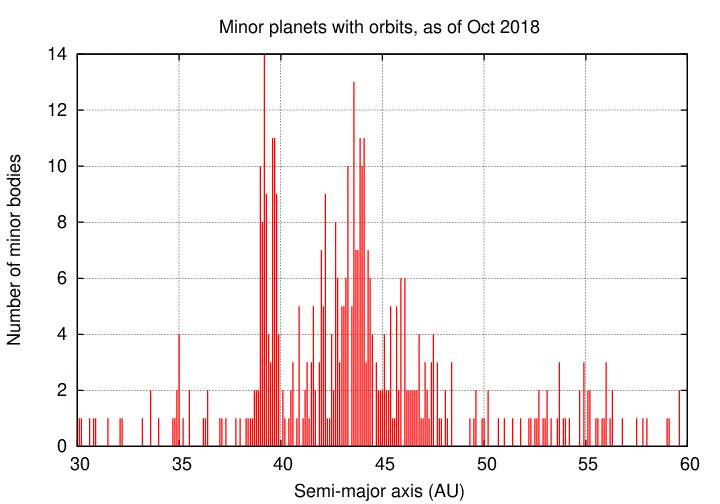
Let's check to see how Neptune might affect objects in or near the Kuiper Belt. Suppose that one particular object has an orbit which falls into a gravitational resonance with Neptune as follows. Neptune's orbit has a period of PNep = 164.8 years If a small body should happen to have an orbit which is exactly twice as long -- meaning that it falls into a 1:2 resonance with Neptune -- then the periodic gravitational perturbations would cause its orbit to change.


Q: What is the period of a body in a 1:2 resonance with Neptune? Q: What is the semi-major axis of that body's orbit?
 Copyright © Michael Richmond.
This work is licensed under a Creative Commons License.
Copyright © Michael Richmond.
This work is licensed under a Creative Commons License.